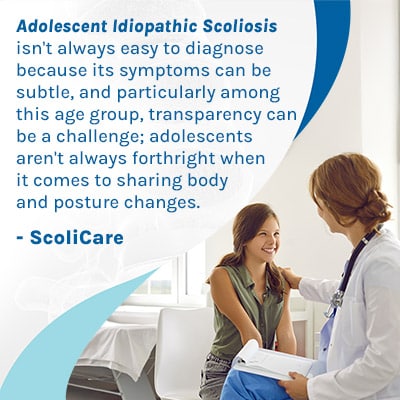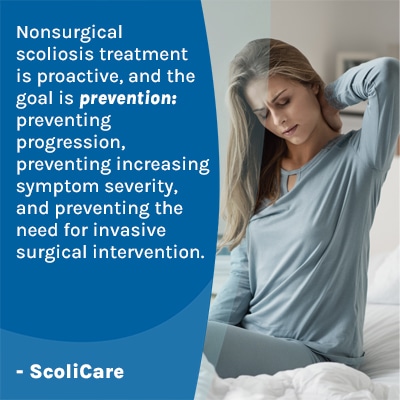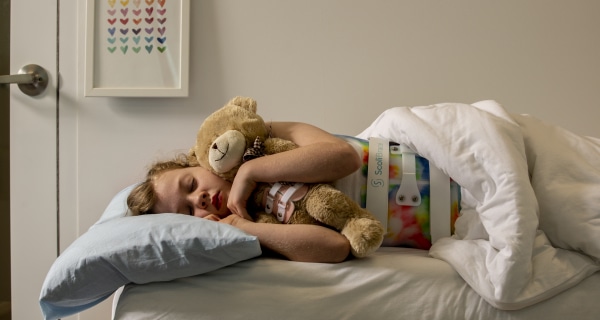Diagnosing scoliosis early means while it’s still mild, and while there are no treatment guarantees, early detection and intervention are associated with treatment success.
Adolescent Idiopathic Scoliosis is the most common form of scoliosis; it’s diagnosed between the ages of 10 and reaching young adulthood. This age group is also the most prone to rapid advancement due to the stage of growth they are in. Symptoms include postural and movement changes, and treatment needs to be proactive.Add News
Adolescent scoliosis isn’t always easy to detect, so let’s start with how it’s diagnosed.
What is Adolescent Idiopathic Scoliosis?
Adolescent Idiopathic Scoliosis(AIS) is diagnosed if an unnatural lateral S-shaped spinal curvature with rotation develops in children or adolescents between the ages of 10 and reaching young adulthood.
In most cases, it’s diagnosed around 11 or 12 years in females, and males tend to be diagnosed later; this is likely due to the earlier onset of puberty in females (1, 2).
It’s estimated that 90 percent of scoliosis cases involve females, and most adolescents diagnosed with scoliosis are otherwise healthy (1).
Scoliosis can affect all ages, but adolescents are the most frequently diagnosed, with estimates of up to 5 percent of all children developing the spinal condition (1).
 Adolescent Idiopathic Scoliosis isn’t always easy to diagnose because its symptoms can be subtle, and particularly among this age group, transparency can be a challenge; adolescents aren’t always forthright when it comes to sharing body and posture changes.
Adolescent Idiopathic Scoliosis isn’t always easy to diagnose because its symptoms can be subtle, and particularly among this age group, transparency can be a challenge; adolescents aren’t always forthright when it comes to sharing body and posture changes.
Adolescent Scoliosis Risk Factors
Adolescent Idiopathic Scoliosis typically develops at the onset of puberty and is more common in females. Age and gender are considered risk factors.
A risk factor is a variable that increases the risk of being diagnosed with a medical condition, and when it comes to scoliosis, age, gender, and a family history warrant early screening (1, 2, 3, 4).
While scoliosis isn’t considered genetic, it does run in families, so scoliosis is considered to be familial: caused by multiple factors that families share: body type, diet, lifestyle, posture, geography, and more (3).
So if these risk factors are in place, it’s important for parents to understand the importance of early detection, which can be achieved through regular screening (3).
Early Detection
The first step to diagnosing scoliosis is recognizing its early signs; this is crucial because as a progressive condition triggered by growth, the nature of scoliosis is to become more severe over time, but it can be highly treatable, particularly with early detection and a proactive treatment plan (1, 2, 3).
There are different types of scoliosis, and because the condition also ranges widely in severity from mild scoliosis to moderate scoliosis and severe cases, the symptoms of mild scoliosis can be subtle.
The subtlety of mild scoliosis symptoms can make it difficult to detect, but for parents who are proactive and aware their child has risk factors so undergoes regular screening, diagnosing scoliosis while mild is more than possible (1, 2, 3).
Early detection can mean early intervention, depending on the chosen treatment approach, and for a nonsurgical response that values proactive treatment, assessment will be followed by the customization of a treatment plan started as soon as possible (3).
A scoliosis screening examination involves taking a patient’s family history and performing an Adam’s forward bend test to look for asymmetries in the spine and trunk that warrant the need for further testing in the form of a scoliosis X-ray (3).
An arch in the rib cage is often the main indicator during a forward bend test.
If an X-ray confirms the presence and size of the scoliosis and confirms the rotational component, a diagnosis and comprehensive assessment is needed.
So let’s address why the signs of scoliosis in adolescents can be difficult to detect.
Early Symptoms of Adolescent Idiopathic Scoliosis
With children and adolescents, early detection can allow for treatment to be applied during growth, and this is key because it’s growth that makes scoliosis progress, and progression makes scoliosis more complex to treat because it involves larger curve and established effects (1, 2).
The sooner treatment is started, the better, and the only way to achieve a diagnosis is to first recognize the need for assessment (3).
Postural Changes
Adolescent scoliosis can progress rapidly due to puberty, and in most cases, the earliest signs of Adolescent Idiopathic Scoliosis include uneven shoulders and uneven hips.
An unnatural spinal curve causes the spine and body to become misaligned, and postural changes can become more overt as progression occurs.
In addition to uneven shoulders and hips, uneven shoulder blades, the development of a rib cage arch, and uneven arm and leg length are common; the uneven forces of scoliosis can also disrupt movement.
Mobility Changes
Changes to gait, balance, and coordination can occur, and some cases of adolescent scoliosis involve activity restrictions.
Particularly in cases of lumbar scoliosis that develop in the lower back, pelvic obliquity can develop as the pelvis tilts unnaturally to counteract the unnatural spinal curve above and uneven load bearing, and this can cause an abnormal gait.
The more scoliosis progresses, the more noticeable its effects can be, including postural changes, a prominent lean to one side, ill-fitting clothing, and unhealthy movement patterns.
Pain
A significant challenge to the early detection of adolescent scoliosis is the lack of pain. Scoliosis becomes compressive once skeletal maturity is reached, but while growth is occurring, the spine is constantly being lengthened, and this motion counteracts the uneven pressure of the scoliosis.
When growth stops, however, compression can cause back, muscle, and nerve pain, which is the main symptom of adult scoliosis (5).
So the lack of compressive pain in childhood scoliosis can make it harder to diagnose, especially when mild because its symptoms can be subtle, yet it’s children who have the most to gain from early detection, so what’s the answer? Awareness is the answer because it can lead to early detection and treatment success.
Here at ScoliCare, we’re passionate about education and awareness. Adolescents have a lot to gain from early detection, but I want parents to understand that an early diagnosis of mild scoliosis doesn’t indicate a lack of urgency; what it does indicate is that treatment is necessary, and while curves are smaller, more flexible and responsive to treatment, the potential for nonsurgical treatment success is greater (1, 3).
In addition to correcting smaller and more-flexible curves, many of the effects of progression haven’t occurred at the mild level, so the effects of mild scoliosis are easier to improve/reverse than those associated with moderate and/or severe scoliosis.
So once a diagnosis of Adolescent Idiopathic Scoliosis is reached, what are the treatment options in place?
Adolescent Idiopathic ScoliosisTreatment Options
There are two main factors that shape the design of an adolescent’s scoliosis treatment plan: how much growth they have remaining and the severity of the scoliosis (1, 2).
Scoliosis severity refers to the size of the unnatural spinal curve along with the angle of trunk rotation (ATR), but the size of the curve isn’t the only factor that shapes progression.
A patient’s skeletal age is important to determine as accurately as possible because growth spurts trigger progression, are rapid and unpredictable, and children grow at different rates.
Knowing how much potential growth a patient has yet to go through is a reliable indicator of how much potential progression they may face.
Curvature location is also an important factor as thoracic scoliosis curves are more prone to rapid advancement, due partially to the size of the thoracic spinal section, so part of the diagnostic process involves determining a patient’s potential rate and level of progression.
 Nonsurgical scoliosis treatment is proactive, and the goal is prevention: preventing progression, preventing increasing symptom severity, and preventing the need for invasive surgical intervention.
Nonsurgical scoliosis treatment is proactive, and the goal is prevention: preventing progression, preventing increasing symptom severity, and preventing the need for invasive surgical intervention.
When it comes to adolescent idiopathic scoliosis, we’re talking about young patients with more spinal flexibility than adults, so corrective bracing is a proven effective nonsurgical treatment option (6).
The ScoliBrace® is the world’s most advanced corrective brace treatment; it uses spinal coupling to improve a patient’s curve size and postural alignment for 3-dimensional results (6).
The unique design of the ScoliBrace® allows for movement, unlike traditional bracing that uses spinal immobilization, so when combined with the power of a customized scoliosis-specific exercise program, further improvements to the spine’s curve size and posture may be achieved (6).
ScoliBalance® is a customized physiotherapeutic scoliosis-specific exercise program that harnesses the power of exercise to counteract the scoliosis, and through the use of Mirror Image® exercise, patients are taught postural awareness and restoration (6).
Once patients are confident with the exercises learned in-Clinic, they can establish a home-rehabilitation program to further stabilize the spine and sustain treatment results.
Conclusion
ScoliCare doesn’t just want to treat scoliosis, we want to be leaders in research and education. Through awareness, early detection is possible, and while all age groups can benefit from early detection, adolescents in particular have a lot to gain as they are prone to rapid advancement.
Adolescent Idiopathic Scoliosis is the most common type of scoliosis affecting up to 5 percent of all children.
The earliest signs of adolescent scoliosis are often uneven shoulders and hips, and as all children should be regularly screened for scoliosis, considering the potential benefits of early detection, this is particularly important when risk factors such as age, gender, and family history are in place.
While diagnosing scoliosis while mild can have a number of benefits, it’s only beneficial to those whose treatment is proactive, and this characterizes the nonsurgical treatment response.
Nonsurgical treatment is modern, innovative, and integrative, and combines the power of corrective bracing and exercise-based treatment plans that are customized around a patient’s age, skeletal maturity, scoliosis severity, and curvature location.
References:
- Weinstein SL. The Natural History of Adolescent Idiopathic Scoliosis. J Pediatr Orthop. 2019 Jul;39(Issue 6, Supplement 1 Suppl 1):S44-S46. doi: 10.1097/BPO.0000000000001350. PMID: 31169647.
- Negrini S, Donzelli S, Aulisa AG, Czaprowski D, Schreiber S, de Mauroy JC, Diers H, Grivas TB, Knott P, Kotwicki T, Lebel A, Marti C, Maruyama T, O’Brien J, Price N, Parent E, Rigo M, Romano M, Stikeleather L, Wynne J, Zaina F. 2016 SOSORT guidelines: orthopaedic and rehabilitation treatment of idiopathic scoliosis during growth. Scoliosis Spinal Disord. 2018 Jan 10;13:3. doi: 10.1186/s13013-017-0145-8. PMID: 29435499; PMCID: PMC5795289.
- Dunn J, Henrikson NB, Morrison CC, et al. Screening for Adolescent Idiopathic Scoliosis: A Systematic Evidence Review for the U.S. Preventive Services Task Force [Internet]. Rockville (MD): Agency for Healthcare Research and Quality (US); 2018 Jan. (Evidence Synthesis, No. 156.) Chapter 1, Introduction. Available from: https://www.ncbi.nlm.nih.gov/books/NBK493369/
- Wise CA, Gao X, Shoemaker S, Gordon D, Herring JA. Understanding genetic factors in idiopathic scoliosis, a complex disease of childhood. Curr Genomics. 2008 Mar;9(1):51-9. doi: 10.2174/138920208783884874. PMID: 19424484; PMCID: PMC2674301.
- Marty-Poumarat, Catherine MD*; Scattin, Luciana MD†; Marpeau, Michèle MD*; Garreau de Loubresse, Christian MD‡; Aegerter, Philippe MD, PhD§. Natural History of Progressive Adult Scoliosis. Spine 32(11):p 1227-1234, May 15, 2007. | DOI: 10.1097/01.brs.0000263328.89135.a6
- Marchese R, Du Plessis J, Pooke T, McAviney J. The Improvement of Trunk Muscle Endurance in Adolescents with Idiopathic Scoliosis Treated with ScoliBrace® and the ScoliBalance® Exercise Approach. J Clin Med. 2024 Jan 23;13(3):653. doi: 10.3390/jcm13030653. PMID: 38337346; PMCID: PMC10856658.


